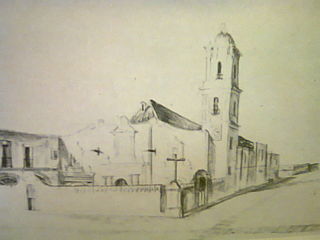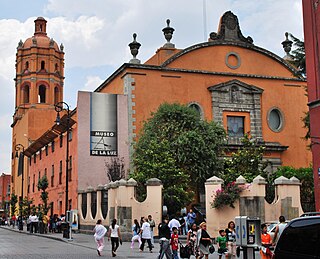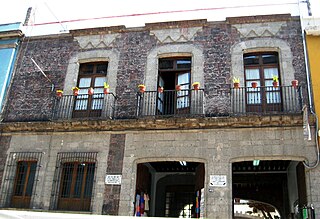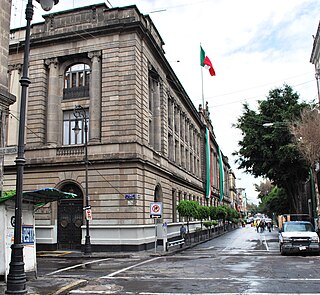
Diego María de la Concepción Juan Nepomuceno Estanislao de la Rivera y Barrientos Acosta y Rodríguez, known as Diego Rivera, was a prominent Mexican painter. His large frescoes helped establish the mural movement in Mexican and international art.

The Palacio de Bellas Artes is a prominent cultural center in Mexico City. This hosts performing arts events, literature events and plastic arts galleries and exhibitions. "Bellas Artes" for short, has been called the "art cathedral of Mexico", and is located on the western side of the historic center of Mexico City which is close to the Alameda Central park.

The University of the Cloister of Sor Juana is a private university located in the former San Jerónimo Convent in the historic center of Mexico City. This convent is best known for having been the home of Sor Juana Inés de la Cruz for over twenty five years, she produced many of her writings here. After the convent was closed in the 19th century, the large complex was divided and was home to a number of institutions and businesses, including a large dance hall in the mid 20th century. In the 1970s, the government expropriated the complex, explored it and began the restoration process. In 1979, the current university was founded at this site and it is currently the benefactor and guardian of the complex. The institution offers bachelors, two masters and two certificates, mostly in the humanities. The institution also sponsors or co-sponsors a number of cultural and educational activities, mostly situated in the historic center of the city.

The Museo de Arte Moderno (MAM) is a museum dedicated to modern Mexican art located in Chapultepec Park in Mexico City.

The historic center of Mexico City, also known as the Centro or Centro Histórico, is the central neighborhood in Mexico City, Mexico, focused on the Zócalo and extending in all directions for a number of blocks, with its farthest extent being west to the Alameda Central. The Zocalo is the largest plaza in Latin America. It can hold up to nearly 100,000 people.

Museo de Arte Contemporáneo de Monterrey, abbreviated as MARCO, is a major contemporary art museum, located in the city of Monterrey, in Nuevo León state of northeastern Mexico.

The Escuela Nacional Preparatoria (ENP), the oldest senior High School system in Mexico, belonging to the National Autonomous University of Mexico (UNAM), opened its doors on February 1, 1868. It was founded by Gabino Barreda, M.D., following orders of then President of Mexico Benito Juárez. It is also modern UNAM's oldest institution.

The Church of San Bernardo stands at the corner of Avenida 20 de Noviembre and Venustiano Carranza Street just south of the Zocalo or main plaza of Mexico City. It was part of a convent of the same name that was founded in 1636, but was closed along with all convents and monasteries during the La Reforma period in 1861. Currently, only the church remains of the convent complex.

The Palace of Iturbide is a large palatial residence located in the historic center of Mexico City at Madero Street #17. It was built by the Count of San Mateo Valparaíso as a wedding gift for his daughter. It gained the name “Palace of Iturbide” because Agustín de Iturbide lived there and accepted the crown of the First Mexican Empire at the palace after independence from Spain. Today, the restored building houses the Fomento Cultural Banamex; it has been renamed the Palacio de Cultura Banamex.

The José Luis Cuevas Museum is located just off the Zócalo within the Historic center of Mexico City, in Mexico City, Mexico. The museum and Church of Santa Inés were built as parts of the Convent of Santa Inés complex. The museum is in the convent's colonial era residential hall.

The Convent of Nuestra Señora de La Merced was a Roman Catholic colonial religious complex in present-day Historic center of Mexico City, that was destroyed to give more space to future buildings. The cloister is all that is left of a monastery complex built in the late 16th and early 17th century by the Mercedarian order. It is located on Uruguay and Talavera Streets in the historic downtown of Mexico City. The complex lent its name to the area around it, La Merced, which in turn, inspired the name of the metro station and the well-known neighborhood Market.

Colegio de San Ildefonso, currently is a museum and cultural center in Mexico City, considered to be the birthplace of the Mexican muralism movement. San Ildefonso began as a prestigious Jesuit boarding school, and after the Reform War it gained educational prestige again as National Preparatory School. This school and the building closed completely in 1978, then reopened as a museum and cultural center in 1992. The museum has permanent and temporary art and archeological exhibitions in addition to the many murals painted on its walls by José Clemente Orozco, Fernando Leal, Diego Rivera, and others. The complex is located between San Ildefonso Street and Justo Sierra Street in the historic center of Mexico City.

Arturo Estrada Hernández is a Mexican painter, one of a group of Frida Kahlo’s students called “Los Fridos.” Estrada is mostly known for his mural work, which remains faithful to the figurative style and ideology of Mexican muralism. He has created murals in various parts of Mexico in both public and private places, including a 1988 mural found in the Centro Médico metro station in Mexico City. He has also taught classes at the Escuela Nacional de Pintura, Escultura y Grabado "La Esmeralda", where he was a student, since 1948 and continues to give classes there and other venues. He lives in his birthplace: Panindicuaro, Michoacán.

The San Pedro y San Pablo College is a colonial church located in the historical center of Mexico City, Mexico.

The Tlaxcala House is located at 40 San Ildefonso Street in the historic center of Mexico City. It is an example of a typical middle-class home of the 18th century, meant that its style is somewhere between the mansions of the wealthy and the houses of the commoners of the time.

The Secretariat of Public Education Main Headquarters building is on the northeast corner of San Ildefonso and República de Argentina streets in the historic center of Mexico City, and used to be part of the largest and most sumptuous convents in New Spain. It was secularized in the 19th century and then taken over by the then-new Secretariat of Public Education after the Mexican Revolution in the early 20th century. The new agency did extensive remodeling work on the building, including covering nearly all the walls of the two inner courtyards with murals. These murals include Diego Rivera’s first large-scale mural project, which he completed in 1928.

The Antigua Escuela de Jurisprudencia building is located on the corner of Republica de Argentina and San Ildefonso Streets in the historic center of Mexico City. The building originally was convent for Dominican nuns called Santa Catalina de Siena.After the Reform Laws the government took possession of the building and worked to turn it into a military barracks, transforming and partially demolishing it. In the meantime, the National University of Mexico, the forerunner of UNAM, had been closed in 1833, and the Jurisprudence School was recreated at the College of San Ildefonso. In 1868, the National Preparatory High School was founded in the same building so the Jurisprudence School moved to the ex Convent of La Encarnación,(now SEP) and finally to the ex Convent of Santa Catalina de Siena. In 1908, Diaz inaugurated this building as the Escuela Nacional de Jurispudencia.

The Frida Kahlo Museum, also known as the Blue House for the structure's cobalt-blue walls, is a historic house museum and art museum dedicated to the life and work of Mexican artist Frida Kahlo. It is located in the Colonia del Carmen neighborhood of Coyoacán in Mexico City. The building was Kahlo's birthplace, the home where she grew up, lived with her husband Diego Rivera for a number of years, and where she later died in a room on the upper floor. In 1957, Diego Rivera donated the home and its contents to turn it into a museum in Frida's honor.
Olga Dondé was a Mexican artist involved in various fields but best known her still life pieces. She was a self-taught painter, who worked for two years until she decided to enter works in a show in 1968. From then she had about 100 showings of her work, including more than forty individual exhibitions in Mexico, the United States, South Americana and Europe. She also founded artistic organizations, an art gallery and a publishing house. Dondé’s work was recognized by admission in the Salón de la Plástica Mexicana, among other honors and her work continues to be shown and honored after her death.






















